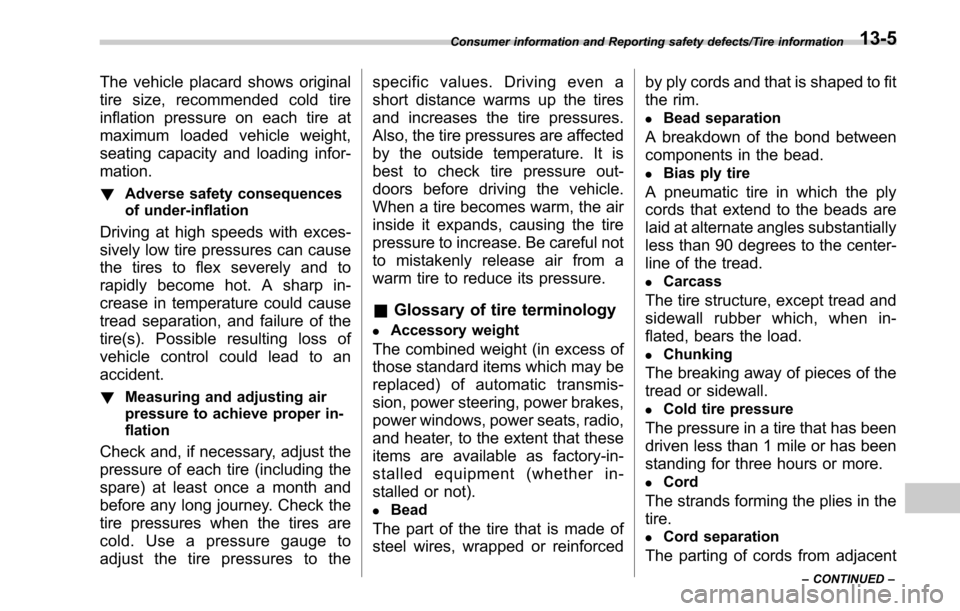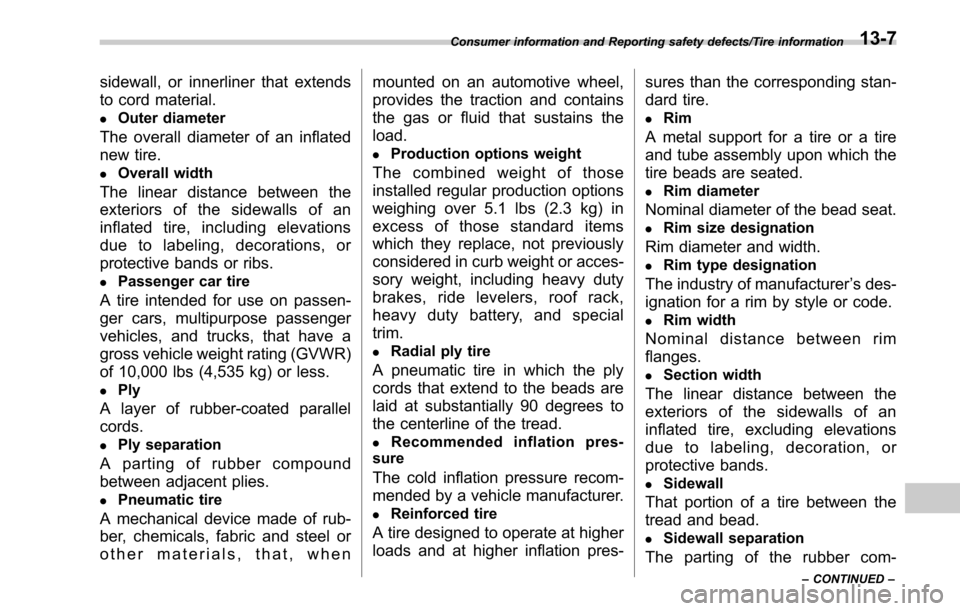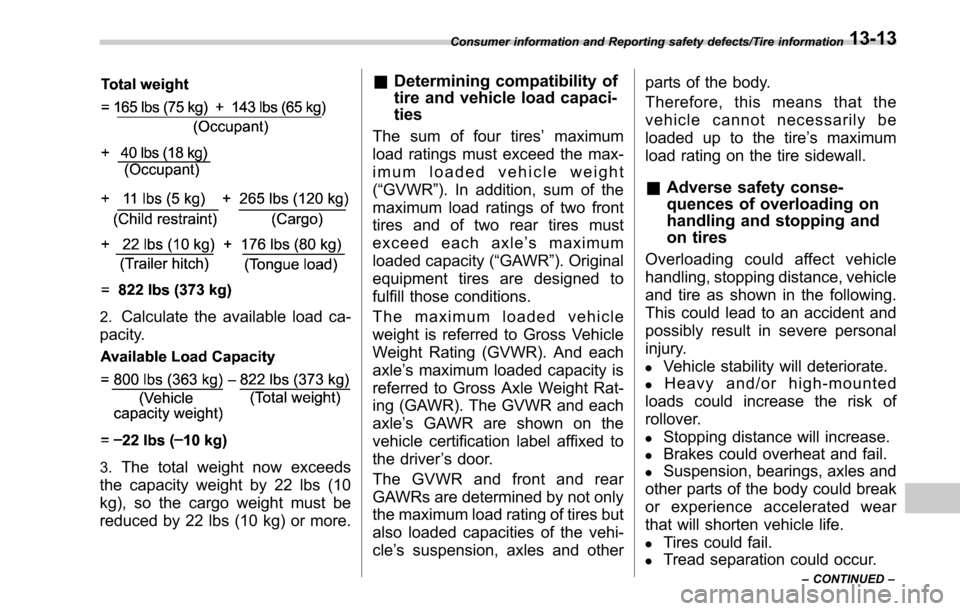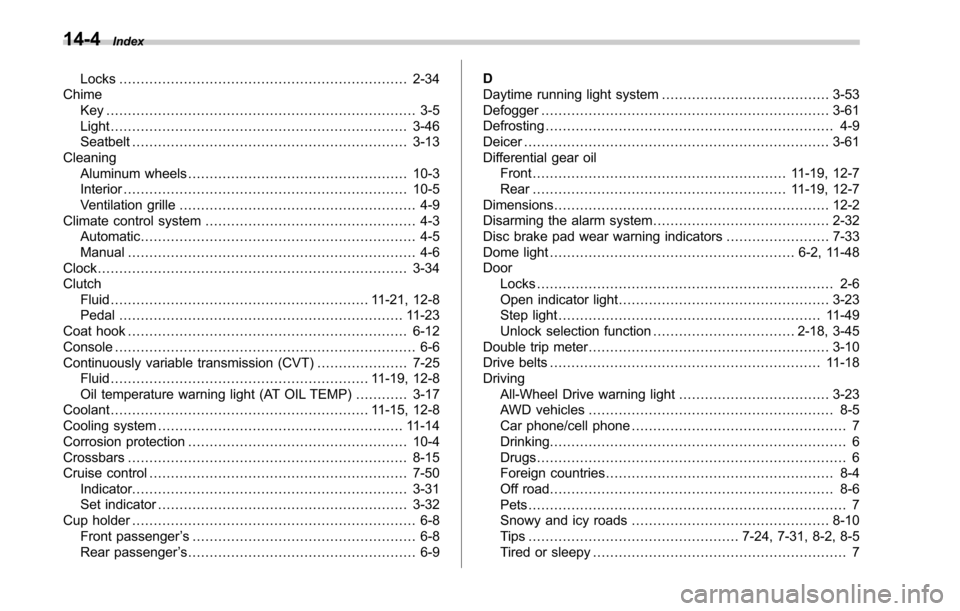2017 SUBARU LEGACY brake
[x] Cancel search: brakePage 563 of 610

Specifications/Specifications
&Fluids
Fluid
Fluid type*1Fluid capacity*2Remarks*3
Continuously variable transmission
fluid (CVT models) Consult your SUBARU dealer. 2.5 L models: 12.0 US qt (11.4 liters,
10.0 Imp qt)
3.6 L models: 13.4 US qt (12.7
liters, 11.2 Imp qt)“
Continuously variable trans-
mission fluid ”F 11-19
Brake fluid FMVSS No. 116, fresh DOT 3 or DOT 4
brake fluid –“
Brake fluid ”F 11-20
Clutch fluid (MT models) FMVSS No. 116, fresh DOT 3 or DOT 4
brake fluid –“
Clutch fluid (MT models) ”F 11 -
21
*1: Use one of the indicated types of fluid.
*2: The indicated fluid quantity is only a guideline. The necessary quantity for replacement may differ slightly depending on the temperature and other
factors.
*3: For more details about maintenance and service, refer to the indicated section.
& Engine coolant
Vehicle model Coolant capacityCoolant type
2.5 L models MT models8.0 US qt (7.6 liters, 6.7 Imp qt)
SUBARU Super Coolant
CVT models 8.2 US qt (7.8 liters, 6.9 Imp qt)
3.6 L models 7.4 US qt (7.0 liters, 6.2 Imp qt)
The indicated coolant quantity is only a guideline. The necessary quantity for replacement may differ slightly depending on the temperature and other
factors. For more details about maintenance and service, refer to “Cooling system ”F 11-14.
12-8
Page 564 of 610

&Electrical system
Battery type
2.5 L models except Canada-spec. models 55D23R
Other models 75D23R
Alternator 12V-130A
Spark plugs 2.5 L models SILZKAR7B11 (NGK)
3.6 L models SILFR6C11 (NGK)
&
Tires
Tire size
225/55R17
97V 225/50R18
95H 225/65R17
102H 225/60R18
100H
Wheel size 1767J
17 67 1/2J 18
67 1/2J 17 67J 18 67J
Pressure Front 33 psi (230 kPa, 2.3 kgf/cm
2)35 psi (240 kPa, 2.4 kgf/cm2)
Rear 32 psi (220 kPa, 2.2 kgf/cm2)33 psi (230 kPa, 2.3 kgf/cm2)
Temporary spare tire Size T155/70 D17 110M T155/80 R17 101M
Pressure 60 psi (420 kPa, 4.2 kgf/cm
2)
Wheel nut tightening torque 88.5 lbf·ft (120 N·m, 12.2 kgf·m)*1
*1: This torque is equivalent to applying approximately 88 to 110 lbf (40 to 50 kgf) at the end of the wheel nut wrench. If you have tightened the wheel
nuts by yourself, have the tightening torque checked at the nearest automotive service facility as soon as possible. For the wheel nut tightening
procedure, refer to“Changing a flat tire ”F 9-5.
& Brake disc
If you need information on the usage limit value of brake discs and the method for measuring them, consult your SUBARU dealer.
Specifications/Specifications12-9
Page 578 of 610

The vehicle placard shows original
tire size, recommended cold tire
inflation pressure on each tire at
maximum loaded vehicle weight,
seating capacity and loading infor-
mation.
!Adverse safety consequences
of under-inflation
Driving at high speeds with exces-
sively low tire pressures can cause
the tires to flex severely and to
rapidly become hot. A sharp in-
crease in temperature could cause
tread separation, and failure of the
tire(s). Possible resulting loss of
vehicle control could lead to an
accident.
!Measuring and adjusting air
pressure to achieve proper in-
flation
Check and, if necessary, adjust the
pressure of each tire (including the
spare) at least once a month and
before any long journey. Check the
tire pressures when the tires are
cold. Use a pressure gauge to
adjust the tire pressures to the specific values. Driving even a
short distance warms up the tires
and increases the tire pressures.
Also, the tire pressures are affected
by the outside temperature. It is
best to check tire pressure out-
doors before driving the vehicle.
When a tire becomes warm, the air
inside it expands, causing the tire
pressure to increase. Be careful not
to mistakenly release air from a
warm tire to reduce its pressure.
&
Glossary of tire terminology
.Accessory weight
The combined weight (in excess of
those standard items which may be
replaced) of automatic transmis-
sion, power steering, power brakes,
power windows, power seats, radio,
and heater, to the extent that these
items are available as factory-in-
stalled equipment (whether in-
stalled or not).
.Bead
The part of the tire that is made of
steel wires, wrapped or reinforced by ply cords and that is shaped to fit
the rim.
.Bead separation
A breakdown of the bond between
components in the bead.
.Bias ply tire
A pneumatic tire in which the ply
cords that extend to the beads are
laid at alternate angles substantially
less than 90 degrees to the center-
line of the tread.
.Carcass
The tire structure, except tread and
sidewall rubber which, when in-
flated, bears the load.
.Chunking
The breaking away of pieces of the
tread or sidewall.
.Cold tire pressure
The pressure in a tire that has been
driven less than 1 mile or has been
standing for three hours or more.
.Cord
The strands forming the plies in the
tire.
.Cord separation
The parting of cords from adjacent
Consumer information and Reporting safety defects/Tire information
–CONTINUED –13-5
Page 580 of 610

sidewall, or innerliner that extends
to cord material.
.Outer diameter
The overall diameter of an inflated
new tire.
.Overall width
The linear distance between the
exteriors of the sidewalls of an
inflated tire, including elevations
due to labeling, decorations, or
protective bands or ribs.
.Passenger car tire
A tire intended for use on passen-
ger cars, multipurpose passenger
vehicles, and trucks, that have a
gross vehicle weight rating (GVWR)
of 10,000 lbs (4,535 kg) or less.
.Ply
A layer of rubber-coated parallel
cords.
.Ply separation
A parting of rubber compound
between adjacent plies.
.Pneumatic tire
A mechanical device made of rub-
ber, chemicals, fabric and steel or
other materials, that, whenmounted on an automotive wheel,
provides the traction and contains
the gas or fluid that sustains the
load.
.Production options weight
The combined weight of those
installed regular production options
weighing over 5.1 lbs (2.3 kg) in
excess of those standard items
which they replace, not previously
considered in curb weight or acces-
sory weight, including heavy duty
brakes, ride levelers, roof rack,
heavy duty battery, and special
trim.
.Radial ply tire
A pneumatic tire in which the ply
cords that extend to the beads are
laid at substantially 90 degrees to
the centerline of the tread.
.Recommended inflation pres-
sure
The cold inflation pressure recom-
mended by a vehicle manufacturer.
.Reinforced tire
A tire designed to operate at higher
loads and at higher inflation pres- sures than the corresponding stan-
dard tire.
.Rim
A metal support for a tire or a tire
and tube assembly upon which the
tire beads are seated.
.Rim diameter
Nominal diameter of the bead seat.
.Rim size designation
Rim diameter and width.
.Rim type designation
The industry of manufacturer
’s des-
ignation for a rim by style or code.
.Rim width
Nominal distance between rim
flanges.
.Section width
The linear distance between the
exteriors of the sidewalls of an
inflated tire, excluding elevations
due to labeling, decoration, or
protective bands.
.Sidewall
That portion of a tire between the
tread and bead.
.Sidewall separation
The parting of the rubber com-
Consumer information and Reporting safety defects/Tire information
–CONTINUED –13-7
Page 586 of 610

2.Calculate the available load ca-
pacity.
3.The total weight now exceeds
the capacity weight by 22 lbs (10
kg), so the cargo weight must be
reduced by 22 lbs (10 kg) or more.
& Determining compatibility of
tire and vehicle load capaci-
ties
The sum of four tires ’maximum
load ratings must exceed the max-
imum loaded vehicle weight
( “ GVWR ”). In addition, sum of the
maximum load ratings of two front
tires and of two rear tires must
exceed each axle ’smaximum
loaded capacity ( “GAWR ”). Original
equipment tires are designed to
fulfill those conditions.
The maximum loaded vehicle
weight is referred to Gross Vehicle
Weight Rating (GVWR). And each
axle ’s maximum loaded capacity is
referred to Gross Axle Weight Rat-
ing (GAWR). The GVWR and each
axle ’s GAWR are shown on the
vehicle certification label affixed to
the driver ’s door.
The GVWR and front and rear
GAWRs are determined by not only
the maximum load rating of tires but
also loaded capacities of the vehi-
cle ’s suspension, axles and other parts of the body.
Therefore, this means that the
vehicle cannot necessarily be
loaded up to the tire
’s maximum
load rating on the tire sidewall.
& Adverse safety conse-
quences of overloading on
handling and stopping and
on tires
Overloading could affect vehicle
handling, stopping distance, vehicle
and tire as shown in the following.
This could lead to an accident and
possibly result in severe personal
injury.
.Vehicle stability will deteriorate.
.Heavy and/or high-mounted
loads could increase the risk of
rollover.
.Stopping distance will increase.
.Brakes could overheat and fail.
.Suspension, bearings, axles and
other parts of the body could break
or experience accelerated wear
that will shorten vehicle life.
.Tires could fail.
.Tread separation could occur.
Consumer information and Reporting safety defects/Tire information
–CONTINUED –13-13
Page 591 of 610

14-2Index
A
Abbreviation................................................................... 3
ABS (Anti-lock Brake System) ..................................... 7-33
Warning light ......................................................... 3-19
Access key ............................................................... 2-10
Warning indicator ................................................... 3-25
Accessories .............................................................. 11-40
Accessory power outlet ............................................... 6-10
Air cleaner element ................................................... 11-15
Air conditioner Automatic climate control system ............................... 4-5
Manual climate control system ................................... 4-6
Air filtration system ..................................................... 4-10
Airflow selection ........................................................... 4-6
Alarm system ............................................................ 2-28
All-Wheel Drive warning light ....................................... 3-23
Aluminum wheel ....................................................... 11-32
Cleaning ............................................................... 10-3
Antenna ...................................................................... 5-2
Anti-lock Brake System (ABS) ..................................... 7-33
Arming the system ..................................................... 2-30
Armrest ..................................................................... 1-15
Ashtray ..................................................................... 6-12
AT OIL TEMP warning light ......................................... 3-17
Audio aha
TMby HARMAN ................................................ 5-44
AM/FM radio ......................................................... 5-28
AUX ..................................................................... 5-61
Base display audio set. ............................................. 5-4
Basic operation ...................................................... 5-18
Bluetooth audio ...................................................... 5-58 CD ....................................................................... 5-53
iPod
...................................................................... 5-56
Pandora
®.............................................................. 5-50
SiriusXM Satellite Radio .......................................... 5-37
Steering switches for audio ...................................... 5-63
SUBARU STARLINK ............................................... 5-26
SUBARU STARLINK
TMMultimedia Plus audio set ... .... 5-6
Unit setting ............................................................ 5-19
USB memory ......................................................... 5-55
Auto on/off headlights ................................................. 3-47
Sensor .................................................................. 3-49
Vehicle setting ........................................................ 3-46
Auto-dimming mirror .................................................... 3-69
Automatic climate control system ................................... 4-5
Automatic headlight beam leveler Warning light .......................................................... 3-32
Automatic Locking Retractor/Emergency Locking Retractor (ALR/ELR) ................................................ 1-17
B
Battery Drainage prevention function ..................................... 2-8
Jump starting ......................................................... 9-11
Replacement (access key) ..................................... 11-50
Replacement (remote engine start transmitter) ........... 7-21
Replacement (transmitter) ...................................... 11-51
Vehicle battery ..................................................... 11-37
Bluetooth
®
Audio .................................................................... 5-58
Hands-free phone system ........................................ 5-71
Settings ................................................................. 5-66
Page 592 of 610

Troubleshooting..................................................... 5-88
Bluetooth®settings ..................................................... 5-66
Booster seat .............................................................. 1-34
Bottle holder ................................................................ 6-9
Brake Assist ................................................................... 7-33
Booster ........................................................ 7-32, 11-22
Disc ..................................................................... 12-9
Fluid ............................................................ 11-20, 12-8
Pad ..................................................................... 11-24
Parking ................................................................. 7-43
Pedal .................................................................. 11-23
System ................................................................. 7-32
Brake pedal Free play ............................................................. 11-23
Reserve distance .................................................. 11-23
Brake system ............................................................ 7-32
Warning light ......................................................... 3-19
Braking ..................................................................... 7-32
Tips...................................................................... 7-32
Breaking-in of new brake pads ................................... 11-24
BSD/RCTA ................................................................ 7-54
Approach indicator light/warning buzzer .................... 7-57
OFF indicator ........................................ 3-32, 3-40, 7-57
OFF switch ........................................................... 7-60
Warning indicator ................................... 3-32, 3-40, 7-59
Warning volume ..................................................... 3-45
Bulb Chart .................................................................. 12-14
Replacing ............................................................. 11-40 C
Cargo area
Cover .................................................................... 6-15
Light ............................................................. 6-3, 11-49
Tie-down hooks ...................................................... 6-19
Catalytic converter ....................................................... 8-3
Center Console ................................................................. 6-6
Changing
Coolant ............................................................... 11-15
Flat tire .................................................................. 9-5
Oil and oil filter ..................................................... 11-13
Charge warning light ................................................... 3-16
CHECK ENGINE warning light/Malfunction indicator light ....................................................................... 3-16
Checking
Brake pedal free play ............................................ 11-23
Brake pedal reserve distance ................................. 11-23
Clutch function ..................................................... 11-23
Clutch pedal free play ........................................... 11-24
Coolant level ........................................................ 11-15
Fluid level (brake fluid) .......................................... 11-20
Fluid level (clutch fluid) .......................................... 11-21
Fluid level (washer fluid) ........................................ 11-32
Oil level (engine oil) .............................................. 11-11
Child restraint systems ................................................ 1-27
Installation of a booster seat .................................... 1-34
Installation with ALR/ELR seatbelt ............................
1-30
Lower and tether anchorages ................................... 1-36
Top tether anchorages ............................................ 1-39
Child safety ................................................................... 5
Index14-3
Page 593 of 610

14-4Index
Locks................................................................... 2-34
Chime Key ........................................................................\
3-5
Light ..................................................................... 3-46
Seatbelt ................................................................ 3-13
Cleaning Aluminum wheels ................................................... 10-3
Interior .................................................................. 10-5
Ventilation grille ....................................................... 4-9
Climate control system ................................................. 4-3
Automatic ................................................................ 4-5
Manual ................................................................... 4-6
Clock ........................................................................\
3-34
Clutch Fluid ............................................................ 11-21, 12-8
Pedal .................................................................. 11-23
Coat hook ................................................................. 6-12
Console ...................................................................... 6-6
Continuously variable transmission (CVT) ..................... 7-25
Fluid ............................................................ 11-19, 12-8
Oil temperature warning light (AT OIL TEMP) ............ 3-17
Coolant ............................................................ 11-15, 12-8
Cooling system ......................................................... 11-14
Corrosion protection ................................................... 10-4
Crossbars ................................................................. 8-15
Cruise control ............................................................ 7-50
Indicator. ............................................................... 3-31
Set indicator .......................................................... 3-32
Cup holder .................................................................. 6-8
Front passenger ’s .................................................... 6-8
Rear passenger ’s..................................................... 6-9 D
Daytime running light system
....................................... 3-53
Defogger ................................................................... 3-61
Defrosting ................................................................... 4-9
Deicer ....................................................................... 3-61
Differential gear oil Front ........................................................... 11-19, 12-7
Rear ........................................................... 11-19, 12-7
Dimensions ................................................................ 12-2
Disarming the alarm system ......................................... 2-32
Disc brake pad wear warning indicators ........................ 7-33
Dome light ......................................................... 6-2, 11-48
Door Locks ..................................................................... 2-6
Open indicator light ................................................. 3-23
Step light ............................................................. 11-49
Unlock selection function ................................. 2-18, 3-45
Double trip meter ........................................................ 3-10
Drive belts ............................................................... 11-18
Driving All-Wheel Drive warning light ................................... 3-23
AWD vehicles ......................................................... 8-5
Car phone/cell phone .................................................. 7
Drinking. ....................................................................
6
Drugs ........................................................................\
6
Foreign countries ..................................................... 8-4
Off road .................................................................. 8-6
Pets ........................................................................\
.. 7
Snowy and icy roads .............................................. 8-10
Tips ................................................. 7-24, 7-31, 8-2, 8-5
Tired or sleepy ........................................................... 7